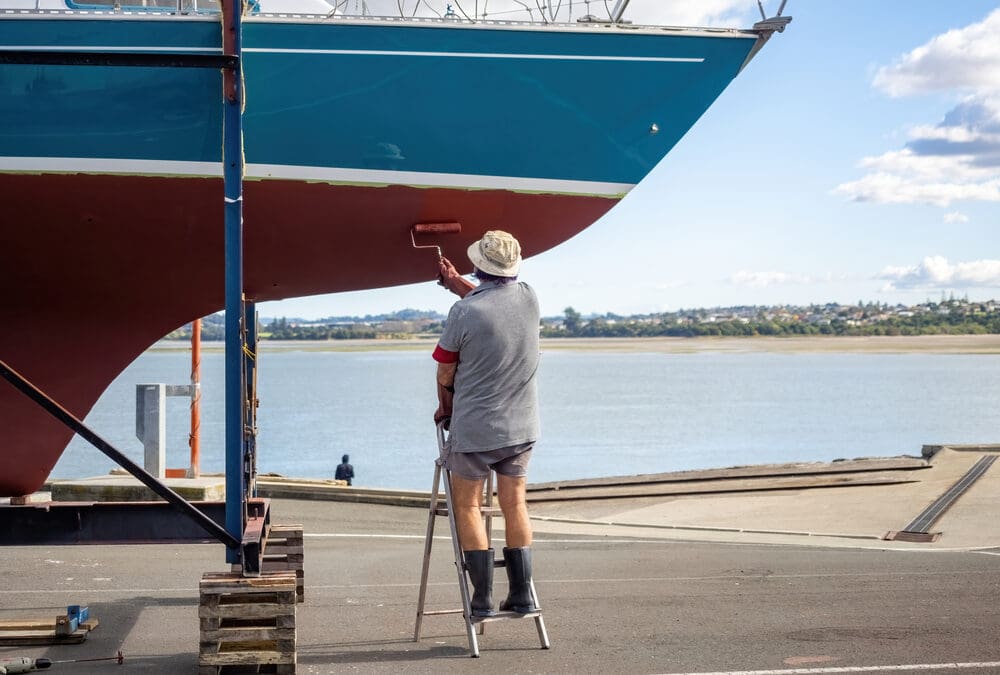Boats are investments that need to be cared for in order to protect your investment and maintain the integrity of the vessel. If you keep your boat in the water then a good bottom paint is one of the best investments you can make to not only protect it, but also for optimal performance while underway.
When you sell your yacht, buyers look at every aspect of the vessel. Many professional yacht brokers recommend a bottom paint job to freshen up its appearance. An old and flaking bottom not only looks bad, but it may cause potential buyers to think your boat has not been maintained properly and assume there will be other issues elsewhere.
What Is Bottom Paint?
Bottom paint is often called antifouling marine paint. This paint has a special type of coating that impedes the growth of aquatic organisms. These destructive organisms can latch on the bottom of the boat, affecting the durability and performance of your yacht. When left on the boat, they can even increase your fuel consumption. The antifouling marine paint repels all of these harmful organisms, saving your yacht from potential damage.
There are three types of antifouling marine paints: hard paints, ablative (soft) paints, and hybrid paints. Hard paints are known as leaching paints. The bottom dries to create a film. As the base contacts water, biocides leach out, eliminating the formation of harmful organisms. Ablative paints also release biocides. They are known to offer more antifouling protection than hard paint and are often the most commonly used paints for recreational boats. The last option is a hybrid paint. These semi-hard paints have all of the benefits of hard and ablative paints. The paints allow the boat’s bottom to resist any slime buildup and hold up to repeated use in the water.
How Often Should You Paint the Boat’s Bottom?
This answer depends on the type of paint you use and how often you take the boat on the water. Boats that stay in the water the entire season will need to be painted more frequently than a boat that is trailered or lift kept. A general rule is to paint the bottom once a year, however, boats that do not spend a lot of time in the water when not is use may be able to stretch the paint out for up to two years.
Will Bottom Paint Slow Down the Yacht?
In some cases, yes. There is much debate about the paint’s effects on the speed of a boat. A hull with a smooth bottom will have less drag and move smoothly through the water. However, if you have lots of layers of bottom paint on your boat and don’t use it often, these layers can create drag through the water and actually slow you down. When you need to paint the bottom of your boat, make sure it is done by a professional. They will ensure that the paint does not interfere with the functionality of the yacht.
The Cost To Paint the Bottom of a Boat
Painting is a necessary task. Most jobs average between $15 to $20 per linear foot. You can absolutely paint the bottom yourself, but it’s a dirty job and you’ll most likely end up spending more time and money to finish the project than what it would cost to hire a professional. The bottom of the boat needs to be properly prepped prior to adding a new coat of paint. Any loose or flaking paint needs to be removed and the rest of the bottom sanded so that the new paint can adhere properly. If you miss this crucial step, the new paint will simply not adhere and you’ll be spending good money for nothing. When you work with a professional, remember that the price can increase after an inspection of the boat depending on how much prep work is required to apply the new paint.
For the DIY project, the cost depends on the type of paint and the size of your boat. Antifouling paint can cost between $100 to $200 per gallon. Along with that, you need paint brushes, sandpaper, paint trays, masking tape, rollers, drop cloths, and a respirator. Your marina may also charge to put a protective cloth under the boat or require you to tent the underside to capture the sanding dust per environmental regulations in your area. That all adds up in price. A simple DIY project can range from $100 to $500+ per project.
Do You Have To Bottom Paint a Boat?
It is not always necessary to bottom paint your boat. If the boat is in the water for short periods of time it may make sense not to paint the bottom. Yachts in a dry storage facility, kept on a boat lift, or boats that are trailered each use don’t need bottom paint. These boats just need regular maintenance with a deep cleaning and a high-quality wax coat. Painting is necessary for those boats that spend more than a week or two at a time in the water, as they need that layer of protection to maintain the hull.
How Long Does It Take for Bottom Paint To Dry?
Make sure to allow plenty of time to paint your boat. Antifouling marine paints do take some time to dry. The hull temperature, relative humidity, and type of paint can all affect the drying time. Remember that hard paints take longer to cure than ablative or hybrid ones. When the temperature is cooler, and the relative humidity is high, the paint requires more time to dry. The general timeline is about four hours. You can launch most boats in 16 hours after being bottom painted. Most professionals recommend giving the paint a total of 72 hours to cure properly.
Don’t Skip Painting the Bottom of a Boat
Bottom painting a boat is essential to maintaining your vessel. It helps increase the lifespan of the hull, improves fuel economy, and decreases the chances of damage to the boat. You will want to have a professional handle this task. Otherwise, you could spend a significant amount of time and money without achieving the right results. A fresh bottom paint also goes a long way to help with the resale value. Potential buyers and your yacht broker will appreciate your extra effort to maintain the boat.
At Yacht Brokers of Annapolis, we know the properly maintained yachts sell for more money than those with poor upkeep. Whether you want to buy or sell your boat, we can help. Schedule a consultation by calling 410-206-2755.





